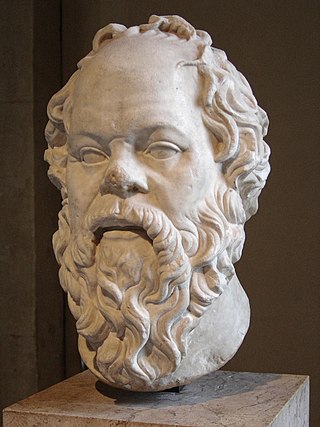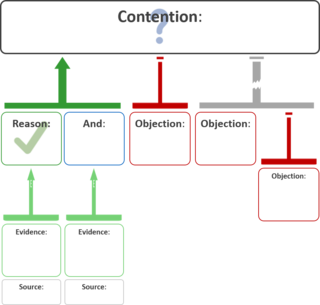In logic and deductive reasoning, an argument is sound if it is both valid in form and its premises are true. Soundness has a related meaning in mathematical logic, wherein a formal system of logic is sound if and only if every well-formed formula that can be proven in the system is logically valid with respect to the logical semantics of the system.
In classical rhetoric and logic, begging the question or assuming the conclusion is an informal fallacy that occurs when an argument's premises assume the truth of the conclusion. Historically, begging the question refers to a fault in a dialectical argument in which the speaker assumes some premise that has not been demonstrated to be true. In modern usage, it has come to refer to an argument in which the premises assume the conclusion without supporting it. This makes it more or less synonymous with circular reasoning.

A syllogism is a kind of logical argument that applies deductive reasoning to arrive at a conclusion based on two propositions that are asserted or assumed to be true.

A fallacy, is the use of invalid or otherwise faulty reasoning in the construction of an argument that may appear to be well-reasoned if unnoticed. The term was introduced in the Western intellectual tradition by the Aristotelian De Sophisticis Elenchis.
Deductive reasoning is the mental process of drawing deductive inferences. An inference is deductively valid if its conclusion follows logically from its premises, i.e. it is impossible for the premises to be true and the conclusion to be false.
In philosophy of logic and logic, a rule of inference, inference rule or transformation rule is a logical form consisting of a function which takes premises, analyzes their syntax, and returns a conclusion.
Inferences are steps in reasoning, moving from premises to logical consequences; etymologically, the word infer means to "carry forward". Inference is theoretically traditionally divided into deduction and induction, a distinction that in Europe dates at least to Aristotle. Deduction is inference deriving logical conclusions from premises known or assumed to be true, with the laws of valid inference being studied in logic. Induction is inference from particular evidence to a universal conclusion. A third type of inference is sometimes distinguished, notably by Charles Sanders Peirce, contradistinguishing abduction from induction.

An enthymeme is an argument with a hidden premise. Enthymemes are usually developed from premises that accord with the audience's view of the world and what is taken to be common sense. However, where the general premise of a syllogism is supposed to be true, making the subsequent deduction necessary, the general premise of an enthymeme is merely probable, which leads only to a tentative conclusion. Originally theorized by Aristotle, there are four types of enthymeme, at least two of which are described in Aristotle's work.

The Kalam cosmological argument is a modern formulation of the cosmological argument for the existence of God. It is named after the Kalam, from which its key ideas originated. William Lane Craig was principally responsible for giving new life to the argument in the 20th century, due to his book The Kalām Cosmological Argument (1979), among other writings.
A false premise is an incorrect proposition that forms the basis of an argument or syllogism. Since the premise is not correct, the conclusion drawn may be in error. However, the logical validity of an argument is a function of its internal consistency, not the truth value of its premises.
In reasoning and argument mapping, a counterargument is an objection to an objection. A counterargument can be used to rebut an objection to a premise, a main contention or a lemma. Synonyms of counterargument may include rebuttal, reply, counterstatement, counterreason, comeback and response. The attempt to rebut an argument may involve generating a counterargument or finding a counterexample.
In logic and philosophy, a formal fallacy, deductive fallacy, logical fallacy or non sequitur is a pattern of reasoning rendered invalid by a flaw in its logical structure that can neatly be expressed in a standard logic system, for example propositional logic. It is defined as a deductive argument that is invalid. The argument itself could have true premises, but still have a false conclusion. Thus, a formal fallacy is a fallacy where deduction goes wrong, and is no longer a logical process. This may not affect the truth of the conclusion, since validity and truth are separate in formal logic.

An argument map or argument diagram is a visual representation of the structure of an argument. An argument map typically includes all the key components of the argument, traditionally called the conclusion and the premises, also called contention and reasons. Argument maps can also show co-premises, objections, counterarguments, rebuttals, and lemmas. There are different styles of argument map but they are often functionally equivalent and represent an argument's individual claims and the relationships between them.
A co-premise is a premise in reasoning and informal logic which is not the main supporting reason for a contention or a lemma, but is logically necessary to ensure the validity of an argument. One premise by itself, or a group of co-premises can form a reason.
A premise or premiss is a proposition—a true or false declarative statement—used in an argument to prove the truth of another proposition called the conclusion. Arguments consist of a set of premises and a conclusion.
The paradoxes of material implication are a group of true formulae involving material conditionals whose translations into natural language are intuitively false when the conditional is translated as "if ... then ...". A material conditional formula is true unless is true and is false. If natural language conditionals were understood in the same way, that would mean that the sentence "If the Nazis had won World War Two, everybody would be happy" is vacuously true. Given that such problematic consequences follow from a seemingly correct assumption about logic, they are called paradoxes. They demonstrate a mismatch between classical logic and robust intuitions about meaning and reasoning.
An argument is a series of sentences, statements, or propositions some of which are called premises and one is the conclusion. The purpose of an argument is to give reasons for one's conclusion via justification, explanation, and/or persuasion.
In logic, specifically in deductive reasoning, an argument is valid if and only if it takes a form that makes it impossible for the premises to be true and the conclusion nevertheless to be false. It is not required for a valid argument to have premises that are actually true, but to have premises that, if they were true, would guarantee the truth of the argument's conclusion. Valid arguments must be clearly expressed by means of sentences called well-formed formulas.
An ontological argument is a philosophical argument, made from an ontological basis, that is advanced in support of the existence of God. Such arguments tend to refer to the state of being or existing. More specifically, ontological arguments are commonly conceived a priori in regard to the organization of the universe, whereby, if such organizational structure is true, God must exist.





